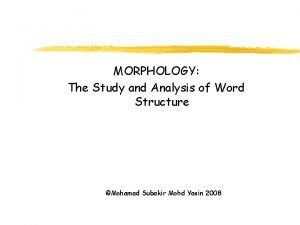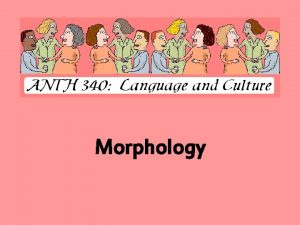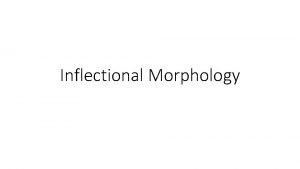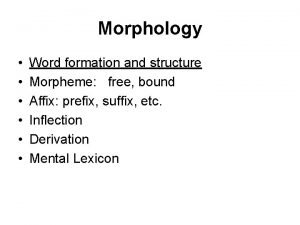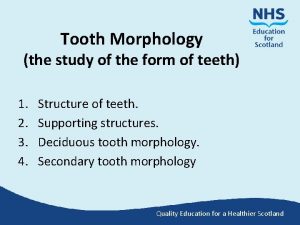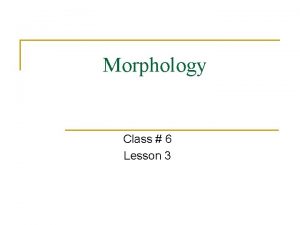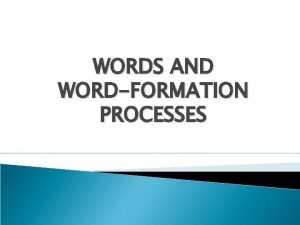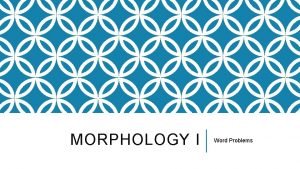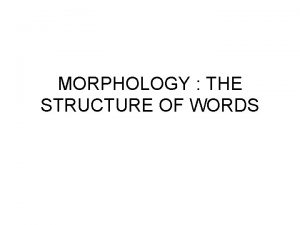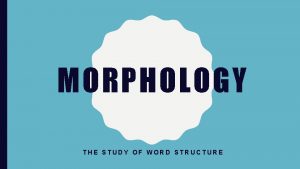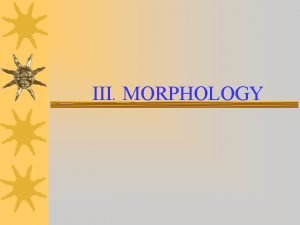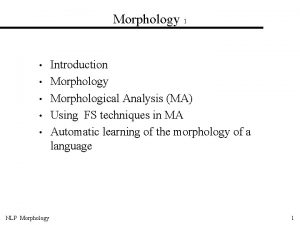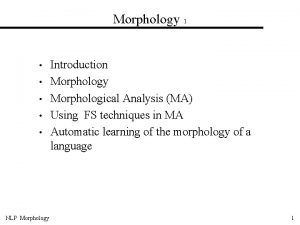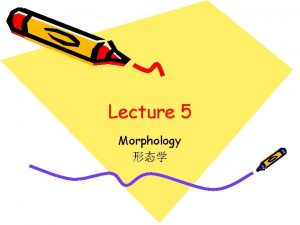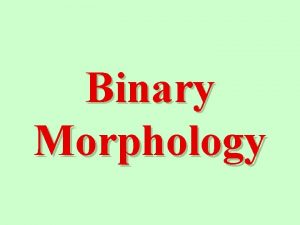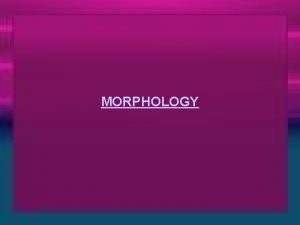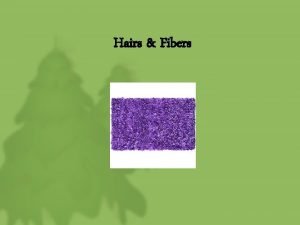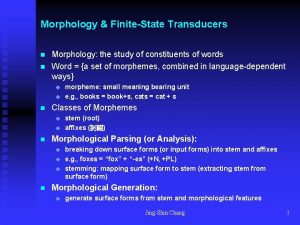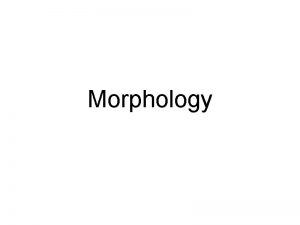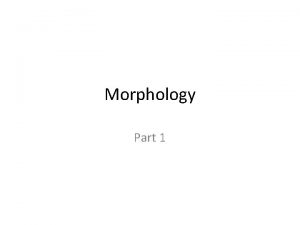MORPHOLOGY The Study and Analysis of Word Structure



























- Slides: 27

MORPHOLOGY: The Study and Analysis of Word Structure ©Mohamad Subakir Mohd Yasin 2008

A. WHAT IS MORPHOLOGY? l The linguistic studies which emphasized the relationships between morpheme and its variants (Asmah Omar 1986). l The study of word forms and word classifications (Nik Safiah Karim 1988).

l The smallest element which has a meaning in a particular language (Hockett 1954) l The internal structures of words (Lyons 1978). l Words are the smallest free forms found in language = an element that can occur in isolation/on its own.

l The most important concept in morphology is MORPHEME. l What is a Morpheme? ‘a minimal unit of meaning or grammatical function’ (G. Yule 1996) ‘unit tatabahasa terkecil yang bermakna, samada makna leksikal atau makna fungsian’ (Kamus Linguistik DBP)

z the smallest unit z free and bound z has meaning z has grammatical function z smaller than word z all words are morphemes, but not all morphemes are words.

MORPHEME example I: diberitahukannya z beri z di + beri + tahu + kan + nya

MORPHEME example II: i. men ii. bicycles z man + plural z cycle z bi + cycle + plural

B. TYPES OF MORPHEMES i. FREE/LEXICAL MORPEHEMES z can stand on its own z has its own meaning z example: rumah, buku, cantik z example: boy, buy, big

ii. BOUND/GRAMMATICAL MORPHEMES z Meaning depends on the structure they are combined with. z Cannot stand on their own. z Example: tawa, rama, ber-, -an z Example: of, the, affixes

C. ALLOMORPHS z z z A single morpheme can have many forms (variants). This variant of the same morpheme is called ALLOMORPH. In English, there is a single morpheme that ‘express indefiniteness’ but it has two variants/forms: a and an.

What is the condition that allows us to choose either ‘a’ or ‘an’ to express indefiniteness? z Plural morpheme ‘s’ also has diff. forms: cats [s] dogs [z] judges [ z] y three diff. allomorphs for a single morpheme ‘s’ that indicates plurality. z

z z Active marker morpheme {Me. N} in BM has 6 variants/forms: MEMBERI MENCARI MENGKAJI MENGEPOS MELAWAN MENYAPU The pronunciation changes according to the environment, but it is still one morpheme.

D. Derivational Morphology z z Formation of new words with a meaning distinct from its base through the addition of an affix. Creating new words by changing the meaning of the base words by adding affixes: INAPPROPRIATE, DISALLOW, REBORN.

z Can also change word class (part of speech) and meaning: MINUM - MINUMAN, SIMPLE – SIMPLY, JUDGE – JUDGEMENT. z Examples of English derivational affixes: -able -er -ment -ful

E. Inflectional Morphology z z Do not change the word class (part of speech) even though affixes have been added – big and bigger are both adjectives. Indicate only syntactic relations, for example: -S for AGREEMENT and PLURALITY.

F. Morphological Processes z z z A process where new words are produced, invented, or created in language. Adding a new meaning to existing words or morphemes. Changes the form of words.

z Main morphological processes in English and BM: 1. Affixation 2. Duplication 3. Acronyms

1. Affixation z z z Affixes added to stems (root words). New words are classified into new classes/categories. Types of affixation: a. prefixes b. suffixes c. infixes d. circumfixes

2. Reduplication z (Re)Duplicating parts or all elements of the stems. z The new forms are known as duplicated words.

3. Acronyms z Combination of certain elements of words, or z Short forms from combination of a few words. z 2 types of acronyms: a. combination of initial letters of root words (and rewritten in capital letters) b. combination of the first syllables of root words.

Activities 1. How many morphemes do the following words have? Identify the morphemes. fly succotash desks enlightens dislike feet payment geese delight prematurely Mississippi optionality sup judgmental catsup misdemeanor

2. All but one of the following Persian words consist of more than one morphemes (Note: xar means ‘buy’ and –id designates the past tense). xaridam ‘I bought’ xaridi ‘you (sg) bought’ xarid ‘bought’ naxaridam ‘I did not buy’ namixaridand ‘they were not buying’ naxaridim ‘we did not buy’ mixarid ‘was buying’

Try to match each of the following nations with a morpheme in the Persian data. I ____ they ____ you (sg)____ not _____ we ____ was/were + -ing ___ you (pl) ____ How would you say ‘you (sg) did not buy’ in Persian? ___________

z z z z z Morphological Knowledge Your knowledge of English morphology is amply illustrated by Lewis Carroll: (3) Lewis Carroll and Through the Looking Glass (1872) and Alice in Wonderland (1865). . . Jabberwocky Twas brillig, and the slithy toves Did gyre and gimble in the wabe: All mimsy were the borogroves, And the mome raths outgrabe. . . .

z Although some of these words are non-occurring English words, you know that they are all potentially meaningful and legitimate words of English. In fact, you also know what parts of speech (category) some of these words belong to, and may even imagine what they might mean.

z (1) Take the first stanza of Lewis Carroll's Jabberwocky, and z (a) identify the category that each word must or most probably belongs to, z (b) single out word(s) whose category seems difficult to identify, z (c) write a parody of this stanza with actual English words, using your own imagination. z Discuss and support your answers to (a) and (b) if you wish, for thoroughness.

z (2) Based on your own intuition about English, z (a) create 5 new English words (new "words" that you are sure are not listed in any English dictionary, but are legitimate English coinages). Indicate why they are possible, though not occurring, English words, should the need arise to coin them. Exclude from your discussion any foreign words borrowed into English or foreign proper names. z (b) give five examples that cannot possibly be English words, and indicate why.
 Succotash morphemes
Succotash morphemes Example of morphology
Example of morphology What is inflectional and derivational morphology
What is inflectional and derivational morphology Morphology definition
Morphology definition Maxillary tooth
Maxillary tooth Word class
Word class Unbelievable affix
Unbelievable affix Word formation processes examples
Word formation processes examples Word sums morphology
Word sums morphology Hình ảnh bộ gõ cơ thể búng tay
Hình ảnh bộ gõ cơ thể búng tay Lp html
Lp html Bổ thể
Bổ thể Tỉ lệ cơ thể trẻ em
Tỉ lệ cơ thể trẻ em Voi kéo gỗ như thế nào
Voi kéo gỗ như thế nào Chụp phim tư thế worms-breton
Chụp phim tư thế worms-breton Chúa sống lại
Chúa sống lại Các môn thể thao bắt đầu bằng tiếng bóng
Các môn thể thao bắt đầu bằng tiếng bóng Thế nào là hệ số cao nhất
Thế nào là hệ số cao nhất Các châu lục và đại dương trên thế giới
Các châu lục và đại dương trên thế giới Công thức tính thế năng
Công thức tính thế năng Trời xanh đây là của chúng ta thể thơ
Trời xanh đây là của chúng ta thể thơ Mật thư anh em như thể tay chân
Mật thư anh em như thể tay chân Phép trừ bù
Phép trừ bù Phản ứng thế ankan
Phản ứng thế ankan Các châu lục và đại dương trên thế giới
Các châu lục và đại dương trên thế giới Thơ thất ngôn tứ tuyệt đường luật
Thơ thất ngôn tứ tuyệt đường luật Quá trình desamine hóa có thể tạo ra
Quá trình desamine hóa có thể tạo ra Một số thể thơ truyền thống
Một số thể thơ truyền thống
